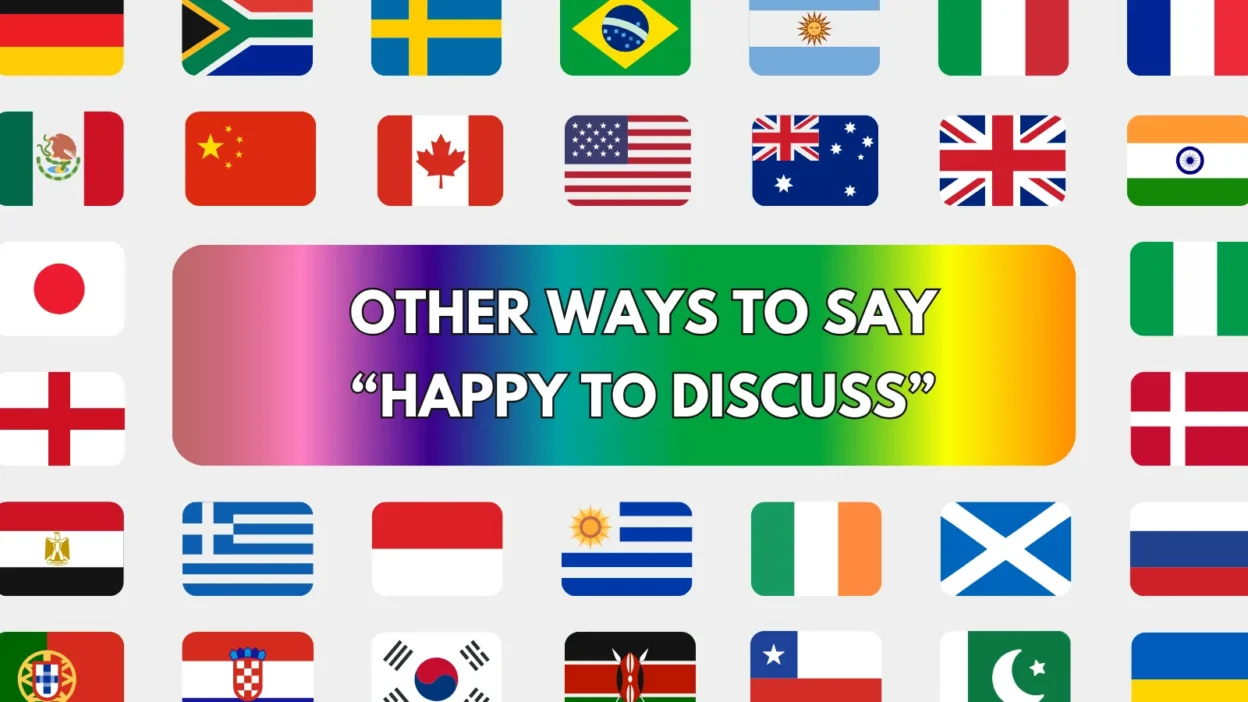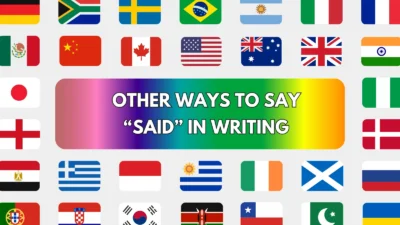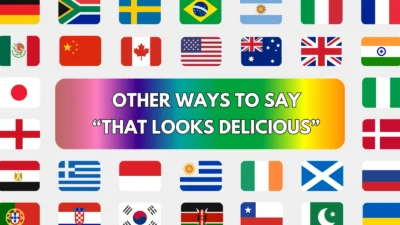The phrase “happy to discuss” is a polite and professional way to show that you’re open to conversation, collaboration, or clarification. But sometimes, you might want to use a different expression that fits your tone — whether you’re writing an email, joining a meeting, or chatting with a colleague.
Here are 25 clear and natural alternatives to “happy to discuss”, complete with their meanings, examples, best uses, and tones so you can choose the right one for any situation.
1. Glad to talk about it
Meaning: Willing and pleased to have a discussion.
Detailed Explanation: Friendly and approachable, suitable for both formal and informal contexts.
Scenario Example: I’m glad to talk about it further whenever you’re available.
Best Use: General professional communication.
Tone: Polite, open.
2. Open to further discussion
Meaning: Indicates you’re willing to continue the conversation.
Detailed Explanation: Shows flexibility and professionalism without being overly emotional.
Scenario Example: I’m open to further discussion if needed.
Best Use: Formal emails, team meetings.
Tone: Professional, neutral.
3. Willing to chat
Meaning: Expresses readiness to communicate casually.
Detailed Explanation: Sounds more relaxed and friendly than “discuss.”
Scenario Example: I’m always willing to chat about ideas or next steps.
Best Use: Informal workplace talk, friendly collaboration.
Tone: Warm, approachable.
4. Happy to go over it
Meaning: Suggests reviewing or explaining something together.
Detailed Explanation: Implies patience and helpfulness.
Scenario Example: I’m happy to go over the details when you have time.
Best Use: Work explanations, clarifications.
Tone: Supportive, positive.
5. Let’s connect about it
Meaning: Proposes a discussion or meeting.
Detailed Explanation: Sounds collaborative and modern, often used in business contexts.
Scenario Example: Let’s connect about it later this week to align our plans.
Best Use: Business emails, professional messages.
Tone: Friendly, proactive.
6. I’d love to talk more about it
Meaning: Shows strong enthusiasm to discuss a topic.
Detailed Explanation: Adds warmth and engagement to your communication.
Scenario Example: I’d love to talk more about it and hear your thoughts.
Best Use: Team discussions, creative collaborations.
Tone: Enthusiastic, inviting.
7. I’m available to discuss
Meaning: States availability in a professional tone.
Detailed Explanation: Common in formal emails or scheduling messages.
Scenario Example: I’m available to discuss this matter anytime tomorrow afternoon.
Best Use: Business communication, scheduling calls.
Tone: Neutral, formal.
8. Open to your thoughts
Meaning: Encourages dialogue and input from others.
Detailed Explanation: Suggests receptiveness rather than pushing your own view.
Scenario Example: I’m open to your thoughts on how we can improve this plan.
Best Use: Team collaborations, leadership communication.
Tone: Respectful, engaging.
9. Glad to elaborate
Meaning: Indicates willingness to explain something in more detail.
Detailed Explanation: Professional and concise, often used in formal contexts.
Scenario Example: I’d be glad to elaborate on that point during our meeting.
Best Use: Presentations, reports, or proposals.
Tone: Formal, confident.
10. Happy to clarify
Meaning: Willing to provide more explanation.
Detailed Explanation: A friendly, service-oriented phrase for resolving confusion.
Scenario Example: I’m happy to clarify anything that’s unclear.
Best Use: Customer support, internal communications.
Tone: Helpful, courteous.
11. Open for a quick chat
Meaning: Suggests availability for a short discussion.
Detailed Explanation: Informal and approachable; perfect for fast workplace exchanges.
Scenario Example: I’m open for a quick chat if you’d like to go over this.
Best Use: Colleague communication, project collaboration.
Tone: Friendly, efficient.
12. I’d be delighted to discuss
Meaning: Expresses joy and eagerness to engage in discussion.
Detailed Explanation: A refined alternative that adds charm and positivity.
Scenario Example: I’d be delighted to discuss this further at your convenience.
Best Use: Polite emails, formal meetings.
Tone: Elegant, positive.
13. Let’s talk it through
Meaning: Suggests working together to find a solution.
Detailed Explanation: Encourages teamwork and collaboration.
Scenario Example: Let’s talk it through before we finalize the decision.
Best Use: Problem-solving, decision-making discussions.
Tone: Cooperative, practical.
14. Happy to provide more details
Meaning: Shows readiness to explain or expand on information.
Detailed Explanation: Great for when you want to sound accommodating and professional.
Scenario Example: I’m happy to provide more details if needed.
Best Use: Reports, proposals, or follow-ups.
Tone: Helpful, formal.
15. Always open for discussion
Meaning: Expresses consistent willingness to talk.
Detailed Explanation: Suggests an ongoing openness rather than a one-time offer.
Scenario Example: I’m always open for discussion if you have feedback.
Best Use: Leadership communication, team culture.
Tone: Inviting, professional.
16. Eager to discuss further
Meaning: Communicates strong interest in continuing the conversation.
Detailed Explanation: Balances enthusiasm with professionalism.
Scenario Example: I’m eager to discuss further during our next meeting.
Best Use: Proposals, negotiations, projects.
Tone: Motivated, polished.
17. Let’s have a conversation about it
Meaning: Encourages an open and equal exchange of ideas.
Detailed Explanation: Sounds less formal than “discuss” but equally constructive.
Scenario Example: Let’s have a conversation about it and see what we can decide.
Best Use: Collaborative discussions, planning sessions.
Tone: Friendly, balanced.
18. More than happy to discuss
Meaning: Emphasizes strong willingness and positivity.
Detailed Explanation: A slightly more expressive variation of “happy to discuss.”
Scenario Example: I’m more than happy to discuss this whenever it’s convenient.
Best Use: Customer service, professional correspondence.
Tone: Warm, cheerful.
19. I’m open to exploring it together
Meaning: Shows interest in cooperative thinking or brainstorming.
Detailed Explanation: Encourages teamwork and shared problem-solving.
Scenario Example: I’m open to exploring it together to see what works best.
Best Use: Creative or strategic discussions.
Tone: Collaborative, inclusive.
20. I’d love to exchange ideas
Meaning: Invites a creative and equal discussion.
Detailed Explanation: Works well when you want to sound open-minded and engaging.
Scenario Example: I’d love to exchange ideas and hear your perspective.
Best Use: Brainstorming sessions, peer communication.
Tone: Curious, friendly.
21. Let’s touch base
Meaning: Suggests briefly connecting to update or discuss something.
Detailed Explanation: Common in workplace slang and project management.
Scenario Example: Let’s touch base later this week to review progress.
Best Use: Business emails, follow-ups.
Tone: Professional, casual.
22. Let’s sync up
Meaning: Proposes aligning thoughts or actions.
Detailed Explanation: A modern and informal version of “let’s discuss.”
Scenario Example: Let’s sync up tomorrow to go over the next steps.
Best Use: Team coordination, tech environments.
Tone: Casual, cooperative.
23. Happy to collaborate
Meaning: Expresses excitement about working together.
Detailed Explanation: Focuses on teamwork rather than just discussion.
Scenario Example: I’m happy to collaborate on refining this proposal.
Best Use: Joint projects, creative work.
Tone: Positive, team-oriented.
24. I’m ready to talk whenever you are
Meaning: Shows flexibility and openness to timing.
Detailed Explanation: Polite and considerate, leaving the control to the other person.
Scenario Example: I’m ready to talk whenever you are available.
Best Use: Professional or friendly discussions.
Tone: Courteous, flexible.
25. Let’s brainstorm together
Meaning: Invites creative or problem-solving discussion.
Detailed Explanation: Encourages sharing new ideas openly.
Scenario Example: Let’s brainstorm together and find the best approach.
Best Use: Teamwork, planning, creative industries.
Tone: Energetic, inclusive.
Conclusion
Saying “happy to discuss” is always polite, but using alternatives like “let’s connect about it”, “glad to elaborate”, or “open to your thoughts” can make your communication sound more natural and engaging.
Choose your phrasing based on tone — whether formal, friendly, or collaborative — to keep your conversations dynamic and approachable. Great communication isn’t just about being clear; it’s about connecting meaningfully.




